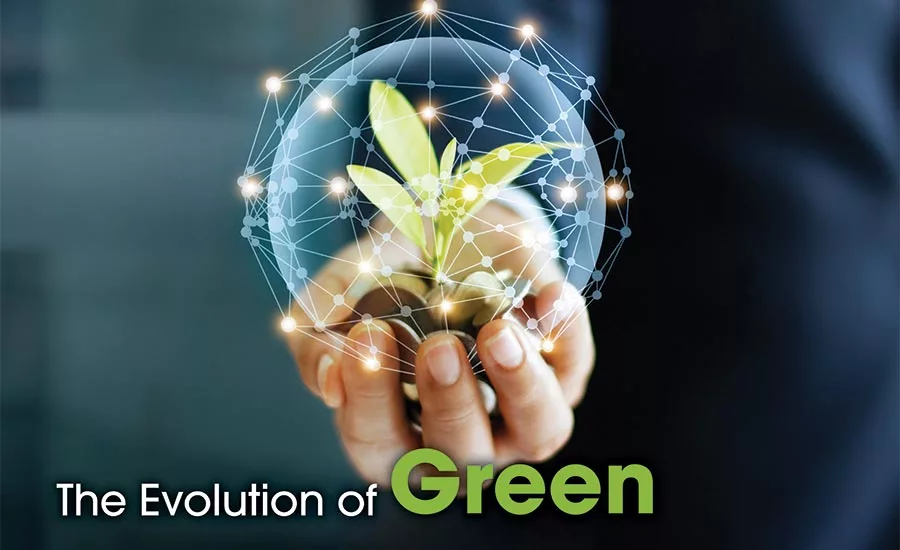The Evolution of Green

While I don’t qualify for senior citizen discounts just yet, I’ve been around awhile, and I’ve seen a few things along the way. Thirty years ago we were well aware of environmental conservation and such, but I’ll guarantee there was little to no consideration given to anything we would now consider “green” when it came to most professional cleaning, coating, disinfecting, and other industry products.
The word “green” was around but it wasn’t until about 20 or so ago when we started calling everything that was slightly less toxic “green.” In that primitive stage of awareness, we would use the “green” version of a product if a customer was sensitive, requested it, or if we were trying to differentiate ourselves from our competitors in the marketplace. …otherwise, we would use the older products we had come to rely on for effectiveness.
“Greenwashing,” 1. also known as green marketing, is a form of marketing employed to make companies (or products) appear more “green”/sustainable than they are in practice. Consider “that guy” we all remember from back in the day who liked to brag about certain abilities and accomplishments (if you know what I mean)… as we’ve become older and wiser we now look back and realize “that guy” most likely wasn’t really “accomplishing” much at all! It’s the same for modern professional products… if you need to make a big deal about being “green”, it’s probably because your product is lacking in performance. Jump forward to 2019, and “green” should be a given.
In the last decade or so, we’ve entered a more mature stage, where it is just assumed any new products have no choice but to be “green.” Now “green” means a combination of features like: non-toxic, sustainable, low VOC, non-sensitizing, biodegradable, recyclable, environmentally friendly, etc. At this point, most of the truly environmentally conscious companies haven’t used the word “green” to describe anything for several years.
Fortunately, these newer products do more than just “actually work.” In most cases, they work better than the 20+ year old formulas. …and most of these are “greener” than ever! ...they just don’t make a big deal about it these days.
“Green” may be a given in new technologies, but where it gets tricky is defining what that means. Is a product that is “made from plants” automatically green? If by “green” you mean environmentally friendly or sustainable then, no. 2. Product components “made directly from plants” are often the exact opposite of “green.” Why? It’s because it takes a lot of inputs and resources to grow, process, and extract the beneficial components from plants. More often it’s more sustainable (environmentally friendly) to synthesize the exact same components. In some cases it takes one-forth of the energy inputs to create a synthetic version of a product compared to the so-called “natural” one.
Is a product ingredient that’s derived directly from plants necessarily “safe?” No, not always.3. In this case, let’s simplify and say that “safe” means EPA Category IV non-toxic and non-irritating in all four categories in the Toxicology section of the Standard SDS Sheet. Chemicals such as Citric Acid as well as D-Limonene and certain other solvents are made from discarded orange peels. Essential oils, some of which are also strong solvents, are distilled directly from various plants. These plant-derived chemical components can be quite dangerous in certain concentrations commonly available in our industry. One look at those SDS sheets 4. & 5. and you will see that not all chemicals derived directly from plants are necessarily “safe.” Safety depends on the formulation and concentration… not where a chemical comes from.
Just like the modern manufacturers who have recently figured out how to create products that perform better AND are also environmentally friendly and safe… we as end-users of professional products need to become more sophisticated and mature in our understanding of what “green” really should mean. As our customers continue to be more informed, we need to keep up. Let’s not be fooled by the wave of “green-washing” continuing in our industry. Take a closer look at the SDS Sheets. Ask questions as to how your products are manufactured.
Bottom line: if your liquid product hasn’t been reformulated in the last 8 years or so, it may be time to start asking some questions or consider upgrading to a modern product.
Sources:
1. History of Greenwashing https://www.aol.com/2011/02/12/the-history-of-greenwashing-how-dirty-towels-impacted-the-green/
2. “Natural” vs Synthetic debate https://blogs.scientificamerican.com/guest-blog/natural-vs-synthetic-chemicals-is-a-gray-matter/
3. Is “Natural” safer? https://nccih.nih.gov/health/know-science/natural-doesnt-mean-better
4. D Limonene Safety Data Sheet https://www.fishersci.com/shop/msdsproxy?productName=AC179390050&productDescription=
5. Natural Thyme Oil Safety Data Sheet https://www.essentialingredients.com/msds/Thyme%20Oil%20Natural.pdf
Looking for a reprint of this article?
From high-res PDFs to custom plaques, order your copy today!







